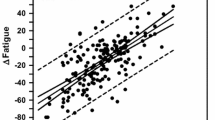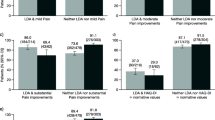Abstract
The interplay between patient-reported outcome measures in rheumatology is not well clarified. The objective of the study was to examine associations on the group level and concordance on the individual patient level between patient global assessment (PaGl), pain, and fatigue as scored on visual analog scales (VAS) in the daily clinic by patients with active rheumatoid arthritis (RA). Associations with other measures of disease activity were also examined. Traditional disease activity data on 221 RA patients with active disease planned to initiate biological treatment were extracted from the Danish DANBIO registry. Associations between VAS PaGl, pain, and fatigue (0–100) were examined using multiple regression analysis. Concordance between the VAS scores was expressed as the bias (mean difference between intra-individual scores) and the 95 % lower and upper limits of agreement (LLoA; ULoA) according to the Bland-Altman method. Mean age was 57 ± 14 years, mean Disease Activity Score (DAS28-CRP4) 5.0 ± 0.9, and mean PaGl 63.6 ± 22.6. PaGl was most strongly predicted by pain and fatigue, pain by PaGl and fatigue, and fatigue by PaGl and pain (beta ranging from 0.17 to 0.69, p < 0.01–0.0001). More objective measures were not or far less predictive. LLoA;ULoA [bias] for PaGl vs. pain was −19.1; 29.5 [5.2], for PaGl vs. fatigue −22.8; 28.6 [2.9], and for fatigue vs. pain −29.2; 33.8 [2.3]. In conclusion, PaGl, pain, and fatigue were most strongly explained by each other, not by more objective clinical measures of disease activity and were nearly identical on the group level. On the individual patient level, however, differences between the scores varied considerably. The findings highlight the challenge of understanding and dealing with traditional patient-reported VAS measures when it comes to individual RA patients in the daily clinic.


Similar content being viewed by others
References
Alamanos Y, Voulgari PV, Drosos AA (2006) Incidence and prevalence of rheumatoid arthritis, based on the 1987 American College of Rheumatology criteria: a systematic review. Semin Arthritis Rheum 36:182–188
Kalyoncu U, Dougados M, Daures JP, Gossec L (2009) Reporting of patient-reported outcomes in recent trials in rheumatoid arthritis: a systematic literature review. Ann Rheum Dis 68:183–190
Kirwan JR, Hewlett SE, Heiberg T, Hughes RA, Carr M, Hehir M et al (2005) Incorporating the patient perspective into outcome assessment in rheumatoid arthritis—progress at OMERACT 7. J Rheumatol 32:2250–2256
Pincus T, Amara I, Segurado OG, Bergman M, Koch GG (2008) Relative efficiencies of physician/assessor global estimates and patient questionnaire measures are similar to or greater than joint counts to distinguish adalimumab from control treatments in rheumatoid arthritis clinical trials. J Rheumatol 35:201–205
Hazes JM, Taylor P, Strand V, Purcaru O, Coteur G, Mease P (2010) Physical function improvements and relief from fatigue and pain are associated with increased productivity at work and at home in rheumatoid arthritis patients treated with certolizumab pegol. Rheumatology (Oxford) 49:1900–1910
Yazici Y, Bergman M, Pincus T (2008) Time to score quantitative rheumatoid arthritis measures: 28-joint count, Disease Activity Score, Health Assessment Questionnaire (HAQ), Multidimensional HAQ (MDHAQ), and Routine Assessment of Patient Index Data (RAPID) scores. J Rheumatol 35:603–609
Pincus T, Yazici Y, Bergman M, Maclean R, Harrington T (2007) A proposed continuous quality improvement approach to assessment and management of patients with rheumatoid arthritis without formal joint counts, based on quantitative Routine Assessment of Patient Index Data (RAPID) scores on a Multidimensional Health Assessment Questionnaire (MDHAQ). Best Pract Res Clin Rheumatol 21:789–804
Fraenkel L, McGraw S (2007) What are the essential elements to enable patient participation in medical decision making? J Gen Intern Med 22:614–619
Sanderson T, Morris M, Calnan M, Richards P, Hewlett S (2010) Patient perspective of measuring treatment efficacy: the rheumatoid arthritis patient priorities for pharmacologic interventions outcomes. Arthritis Care Res (Hoboken) 62:647–656
Boers M, Tugwell P, Felson DT, van Riel PL, Kirwan JR, Edmonds JP et al (1994) World Health Organization and International League of Associations for Rheumatology core endpoints for symptom modifying antirheumatic drugs in rheumatoid arthritis clinical trials. J Rheumatol Suppl 41:86–89
Felson DT, Anderson JJ, Boers M, Bombardier C, Chernoff M, Fried B et al (1993) The American College of Rheumatology preliminary core set of disease activity measures for rheumatoid arthritis clinical trials. Arthritis Rheum 36:729–740
Kirwan JR, Minnock P, Adebajo A, Bresnihan B, Choy E, de Wit M et al (2007) Patient perspective: fatigue as a recommended patient centered outcome measure in rheumatoid arthritis. J Rheumatol 34:1174–1177
Kirwan JR, Hewlett S (2007) Patient perspective: reasons and methods for measuring fatigue in rheumatoid arthritis. J Rheumatol 34:1171–1173
Aletaha D, Landewe R, Karonitsch T, Bathon J, Boers M, Bombardier C et al (2008) Reporting disease activity in clinical trials of patients with rheumatoid arthritis: EULAR/ACR collaborative recommendations. Arthritis Rheum 59:1371–1377
Grøn KL, Ornbjerg LM, Hetland ML, Aslam F, Khan NA, Jacobs JW (2014) The association of fatigue, comorbidity burden, disease activity, disability and gross domestic product in patients with rheumatoid arthritis. Results from 34 countries participating in the Quest-RA program. Clin Exp Rheumatol 32:869–877
Van Hoogmoed D, Fransen J, Bleijenberg G, van Riel P (2010) Physical and psychosocial correlates of severe fatigue in rheumatoid arthritis. Rheumatology (Oxford) 49:1294–1302
Hewlett S (2011) Fatigue in rheumatoid arthritis: time for a conceptual model. An under-acknowledged patient concern requires a new approach. Rheumatology 50:1004–1006
Pollard LC, Choy EH, Gonzalez J, Khoshaba B, Scott DL (2006) Fatigue in rheumatoid arthritis reflects pain, not disease activity. Rheumatology 45:885–889
Thyberg I, Dahlstrom O, Thyberg M (2009) Factors related to fatigue in women and men with early rheumatoid arthritis: the Swedish TIRA study. J Rehabil Med 41:904–912
Huyeser BA, Parker JC, Thoreson R, Smarr KL, Johnson JC, Hoffman R (1998) Predictors of subjective fatigue among individuals with rheumatoid arthritis. Arthritis Rheum 4:2230–2237
Belza BL, Henke CJ, Yelin EH, Epstein WV, Gilliss CL (1993) Correlates of fatigue in older adults with rheumatoid arthritis. Nurs Res 42:93–99
Studenic P, Radner H, Smolen JS, Aletaha D (2012) Discrepancies between patients and physicians in their perceptions of rheumatoid arthritis disease activity. Arthritis Rheum 64:2814–2823
Hetland ML, Christensen IJ, Tarp U, Dreyer L, Hansen A, Hansen IT et al (2010) Direct comparison of treatment responses, remission rates, and drug adherence in patients with rheumatoid arthritis treated with adalimumab, etanercept, or infliximab. Arthritis Rheum 62:22–32
Hetland ML (2011) DANBIO—powerful research database and electronic patient record. Rheumatology (Oxford) 50:69–77
Aletaha D, Smolen J (2005) The Simplified Disease Activity Index (SDAI) and the Clinical Disease Activity Index (CDAI): a review of their usefulness and validity in rheumatoid arthritis. Clin Exp Rheumatol 23(Suppl 39):S100–S108
Madsen OR (2013) Agreement between the DAS28-CRP assessed with 3 and 4 variables in patients with rheumatoid arthritis treated with biological agents in the daily clinic. J Rheumatol 40:379–385
Bland JM, Altman DG (1996) Statistical methods for assessing agreement between two methods of clinical measurement. Lancet 1:307–310
Khan NA, Spencer HJ, Abda EA, Alten R, Pohl C, Ancuta C et al (2012) Patient’s global assessment of disease activity and patient’s assessment of general health for rheumatoid arthritis activity assessment: are they equivalent? Ann Rheum Dis 71:1942–1949
Amaya-Amaya J, Botello-Corzo D, Calixto OJ, Calderón-Rojas R, Domínguez AM, Cruz-Tapias P et al (2012) Usefulness of patients-reported outcomes in rheumatoid arthritis focus group. Arthritis 2012:935187
Nikolaus S, Bode C, Taal E, van de Laar MA (2013) Fatigue and factors related to fatigue in rheumatoid arthritis: a systematic review. Arthritis Care Res (Hoboken) 65:1128–1146
Campbell RC, Batley M, Hammond A, Ibrahim F, Kingsley G, Scott DL (2012) The impact of disease activity, pain, disability and treatments on fatigue in established rheumatoid arthritis. Clin Rheumatol 31:717–722
Wolfe F (2004) Fatigue assessments in rheumatoid arthritis: comparative performance of visual analog scales and longer fatigue questionnaires in 7760 patients. J Rheumatol 31:1896–1902
Sokka T, Pincus T (2005) Quantitative joint assessment in rheumatoid arthritis. Clin Exp Rheumatol 23(Suppl 39):S58–S62
Garip Y, Eser F, Aktekin LA, Bodur H (2011) Fatigue in rheumatoid arthritis: association with severity of pain, disease activity and functional status. Acta Reumatol Port 36:364–369
Bergman MJ, Shahouri SH, Shaver TS, Anderson JD, Weidensaul DN, Busch RE et al (2009) Is fatigue an inflammatory variable in rheumatoid arthritis (RA)? Analyses of fatigue in RA, osteoarthritis, and fibromyalgia. J Rheumatol 36:2788–2794
Riemsma RP, Rasker JJ, Taal E, Griep EN, Wouters JM, Wiegman O (1998) Fatigue in rheumatoid arthritis: the role of self-efficacy and problematic social support. Br J Rheumatol 37:1042–1046
Hewlett S, Cockshott Z, Byron M, Kitchen K, Tipler S, Pope D, Hehir M (2005) Patients’ perceptions of fatigue in rheumatoid arthritis: overwhelming, uncontrollable, ignored. Arthritis Care Res 53:697–702
Higgins NC, Bailey SJ, LaChapelle DL, Harman K, Hadjistavropoulos T (2014) Coping styles, pain expressiveness, and implicit theories of chronic pain. J Psychol 14:1–14
Yuasa S, Yamaguchi H, Nakanishi Y, Kawaminami S, Tabata R, Shimizu N et al (2013) Treatment responses and their predictors in patients with rheumatoid arthritis treated with biological agents. J Med Invest 60:77–90
Walter MJ, Mohd Din SH, Hazes JM, Lesaffre E, Barendregt PJ, Luime JJ (2014) Is tightly controlled disease activity possible with online patient-reported outcomes? J Rheumatol 41:640–647
Ahmed S, Magan T, Vargas M, Harrison A, Sofat N (2014) Use of the pain DETECT tool in rheumatoid arthritis suggests neuropathic and sensitization components in pain reporting. J Pain Res 7:579–588
Hawker GA, Mian S, Kendzerska T, French M (2011) Measures of adult pain: Visual Analog Scale for Pain (VAS Pain), Numeric Rating Scale for Pain (NRS Pain), McGill Pain Questionnaire (MPQ), Short-Form McGill Pain Questionnaire (SF-MPQ), Chronic Pain Grade Scale (CPGS), Short Form-36 Bodily Pain Scale (SF-36 BPS), and Measure of Intermittent and Constant Osteoarthritis Pain (ICOAP). Arthritis Care Res (Hoboken) 63:S240–S252
Disclosures
None.
Funding
None.
Author information
Authors and Affiliations
Corresponding author
Rights and permissions
About this article
Cite this article
Egsmose, E.L., Madsen, O.R. Interplay between patient global assessment, pain, and fatigue and influence of other clinical disease activity measures in patients with active rheumatoid arthritis. Clin Rheumatol 34, 1187–1194 (2015). https://doi.org/10.1007/s10067-015-2968-0
Received:
Revised:
Accepted:
Published:
Issue Date:
DOI: https://doi.org/10.1007/s10067-015-2968-0




